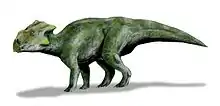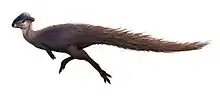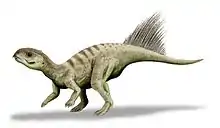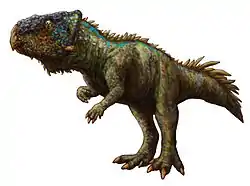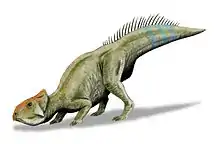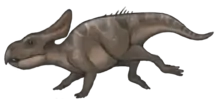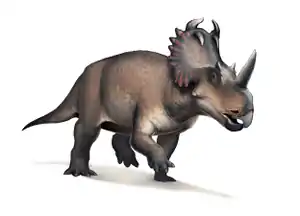Bagaceratops
Bagaceratops (meaning "small-horned face") is a genus of ceratopsian dinosaur that lived in what is now the Barun Goyot Formation and possibly the Djadochta Formation, during the Late Cretaceous. Although emerging late in the reign of the dinosaurs, Bagaceratops had a fairly primitive anatomy and kept the small body size that characterized early ceratopsians.
| Bagaceratops | |
|---|---|
 | |
| Skull | |
| Scientific classification | |
| Kingdom: | Animalia |
| Phylum: | Chordata |
| Clade: | Dinosauria |
| Order: | †Ornithischia |
| Infraorder: | †Neoceratopsia |
| Parvorder: | †Coronosauria |
| Family: | †Bagaceratopidae |
| Genus: | †Bagaceratops Maryanska & Osmolska, 1975 |
| Type species | |
| †Bagaceratops rozhdestvenskyi Maryanska & Osmolska, 1975 | |
| Synonyms | |
| |
History of discovery
The first remains of Bagaceratops were discovered in the Gobi Desert during the 1970s by a joint expedition composed of Mongolian and Polish scientists and it was described in 1975 by two of the expeditions leading scientists, Teresa Maryanska and Halszka Osmólska. Several of these Bagaceratops specimens are at Poland's Paleobiological Institute in Warsaw. The holotype is ZPAL MgD-I/126, a medium-sized skull from the Hermiin Tsav locality of the Barun Goyot Formation, during the Campanian stage of the Late Cretaceous. The generic name, Bagaceratops, means "small-horned face" and is derived from the Mongolian Baga = "small"; Greek ceratops = "horn face". The type and only species, B. rozhdestvenskyi, was named in honor of the Russian paleontologist Anatoly Konstantinovich Rozhdestvensky.[1]

Bagaceratops is known from five complete and twenty partial crania, the longest of which is 17 cm long. The skulls are spread throughout the life stages of the animal, with the smallest being only 4.7 cm long, so the growth stages are relatively well understood. The smaller juvenile skulls were about the same size as a golf ball. Only fragmentary remains of Bagaceratops post-cranial anatomy have been found. Juvenile remains, at first tentatively named Protoceratops kozlowskii, and then renamed Breviceratops kozlowskii by Kurzanov in 1990 are now felt to be juvenile Bagaceratops. Paul Sereno in 2000 explained this by extrapolating that the juvenile Breviceratops would grow into a mature Bagaceratops.[2]
A study on the nature of the observed variation in morphology and size of skulls of Bagaceratops was performed by Łukasz Czepiński in 2019, who also considered the species Gobiceratops minutus, Lamaceratops tereschenkoi, Platyceratops tatarinovi and Magnirostris dodsoni to be potential growth stages of B. rozhdestvenskyi and therefore, junior synonyms.[3] Though the genus remained for a long time without postcranial remains, the first skeleton of Bagaceratops was discovered in 2007 also from the Hermiin Tsav locality of the Barun Goyot Formation, and described by Bitnara Kim and colleagues during 2019. The specimen was catalogued as KID196 and includes a partially complete individual.[4] In 2020, Czepiński described new specimens of Bagaceratops and Protoceratops from the Üüden Sair and Zamyn Khond localities of the Barun Goyot Formation or Djadochta Formation, and evaluated the implications of these specimens for correlation of fossil sites of the latter formation. He considered one of these specimens in particular, MPC-D 100/551B, as a potential evidence of an anagenetic transition from Protoceratops andrewsi to Bagaceratops rozhdestvenskyi.[5]
Description
Bagaceratops grew to an adult size of about 1 metre (3.3 ft) long, 50 centimetres (1.6 ft) high, and weighed around 22 kilograms (50 lb). It had a smaller frill (which lacked fenestrae), and only ten grinding teeth per jaw, and more triangular skull than its close relative, Protoceratops.[2]
Bagaceratops evolved later but retains more primitive characteristics than its earlier relative. Otherwise the two dinosaurs were very similar, each had a beak but no brow horns, and a small horn-like prominence on the snout.[2]
Classification
Bagaceratops belonged to the Ceratopsia, a group of herbivorous dinosaurs with parrot-like beaks which thrived in North America and Asia during the Cretaceous Period, which ended roughly 66 million years ago.
Diet
Bagaceratops, like all ceratopsians, was a herbivore. During the Cretaceous, flowering plants were "geographically limited on the landscape", and so it is likely that this dinosaur fed on the predominant plants of the era: ferns, cycads and conifers. It would have used its sharp ceratopsian beak to bite off the leaves or needles.
See also
References
- Maryańska, T and H. Osmólska (1975). "Protoceratopsidae (Dinosauria) of Asia." Palaeontologia Polonica 33 (1975): 133-181.
- "Bagaceratops." In: Dodson, Peter & Britt, Brooks & Carpenter, Kenneth & Forster, Catherine A. & Gillette, David D. & Norell, Mark A. & Olshevsky, George & Parrish, J. Michael & Weishampel, David B. The Age of Dinosaurs. Publications International, LTD. p. 132. ISBN 0-7853-0443-6.
- Czepiński, Ł. (2019). "Ontogeny and variation of a protoceratopsid dinosaur Bagaceratops rozhdestvenskyi from the Late Cretaceous of the Gobi Desert" (PDF). Historical Biology: 1−28. doi:10.1080/08912963.2019.1593404.
- Kim, B.; Yun, H.; Lee, Y.-N. (2019). "The postcranial skeleton of Bagaceratops (Ornithischia: Neoceratopsia) from the Baruungoyot Formation (Upper Cretaceous) in Hermiin Tsav of southwestern Gobi, Mongolia". Journal of the Geological Society of Korea. 55 (2): 179−190. doi:10.14770/jgsk.2019.55.2.179.
- Czepiński, Ł. (2020). "New protoceratopsid specimens improve the age correlation of the Upper Cretaceous Gobi Desert strata". Acta Palaeontologica Polonica. 65 (3): 481−497. doi:10.4202/app.00701.2019.
